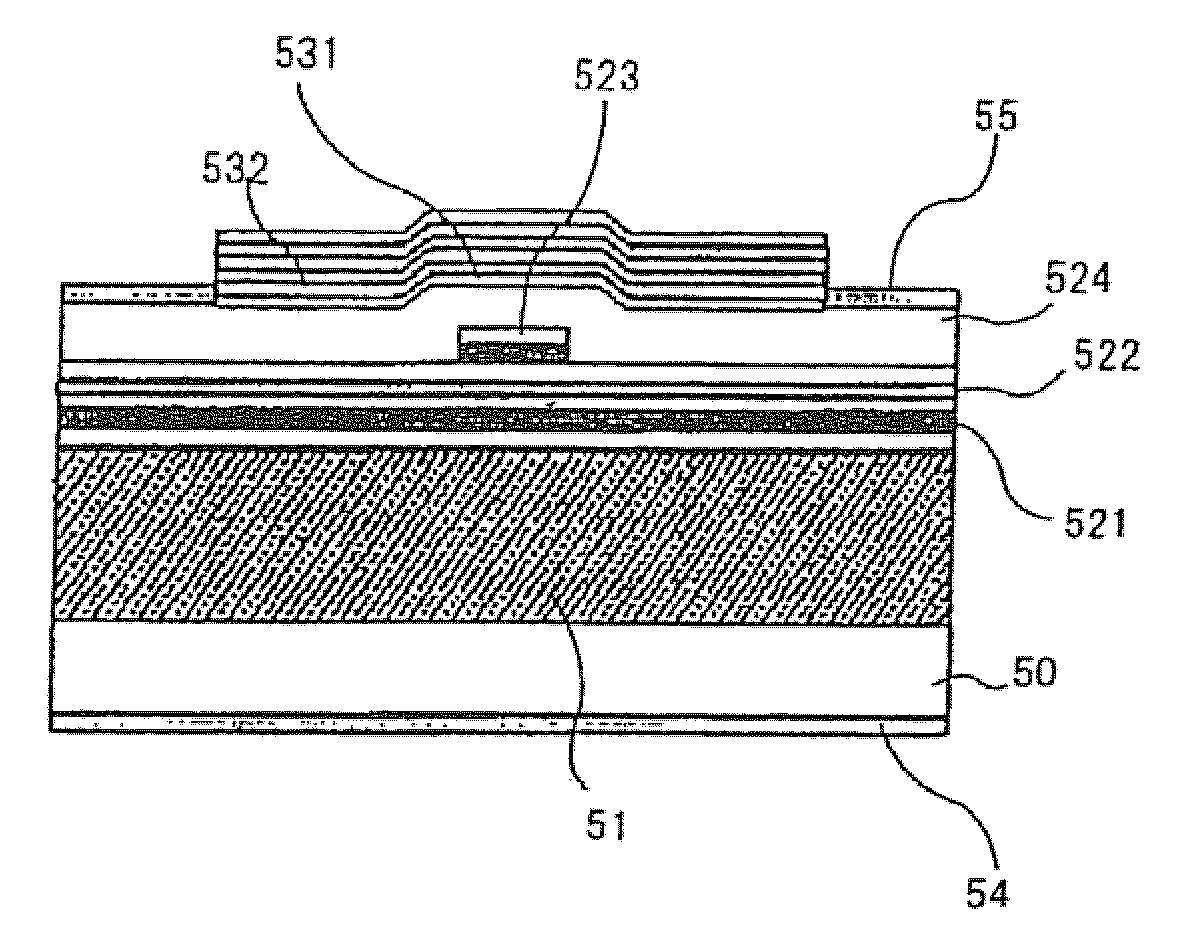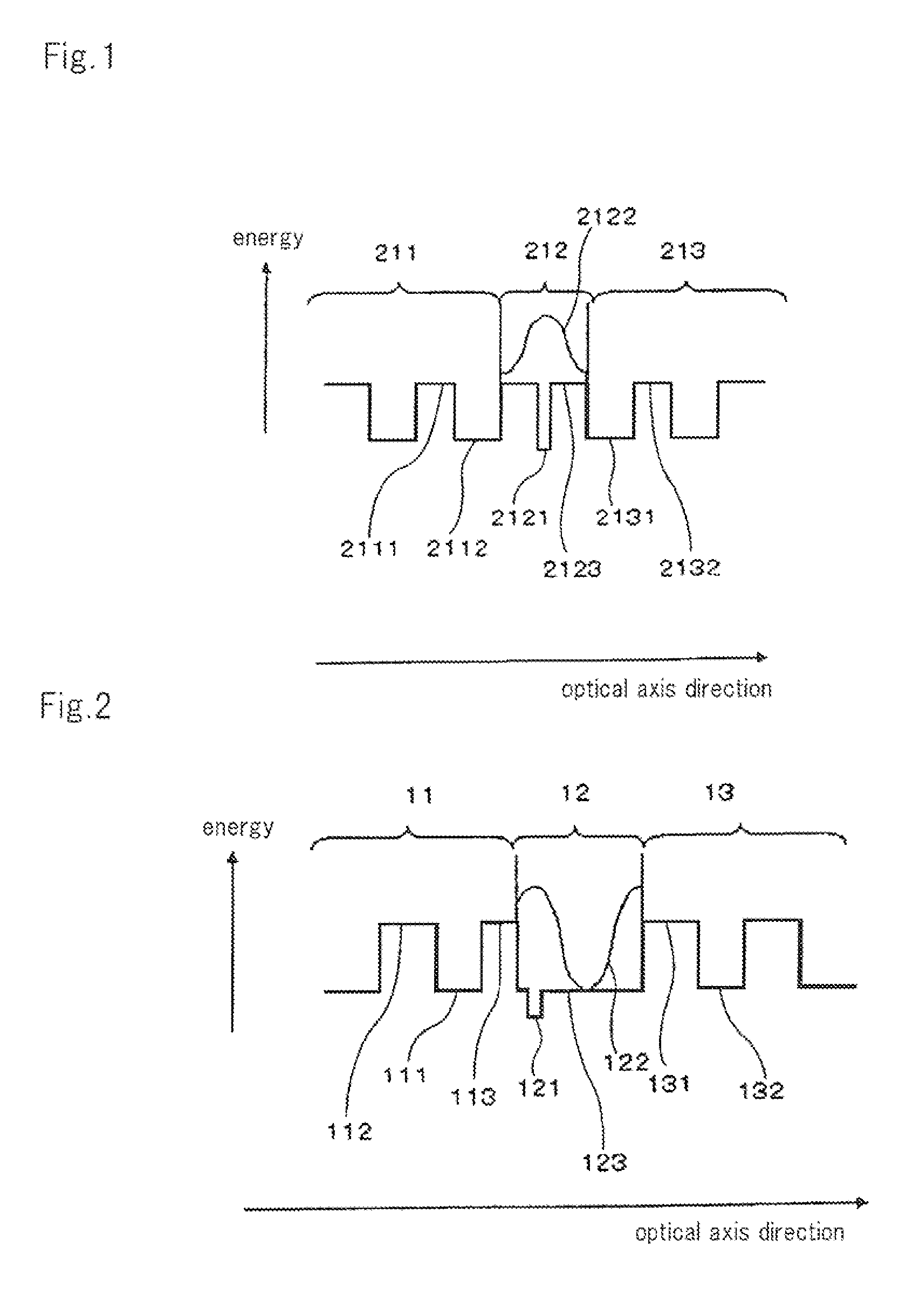Surface emitting laser
a surface emitting laser and laser technology, applied in semiconductor lasers, laser details, electrical equipment, etc., can solve problems such as degrading device characteristics, problem with current injection, and /2 micro-cavity surface emitting lasers, and achieve low-threshold, high-efficiency device characteristics, and light intensity increase
- Summary
- Abstract
- Description
- Claims
- Application Information
AI Technical Summary
Benefits of technology
Problems solved by technology
Method used
Image
Examples
example 1
[0105]FIG. 4A is a diagram showing a band structure and an electric field strength curve of a surface emitting laser according to this Example. The configuration of the surface emitting laser of this Example will be described with reference to FIG. 4A.
[0106]The surface emitting laser of this Example comprises first multilayer Bragg reflecting mirror 31 comprised of a semiconductor material, second multilayer Bragg reflecting mirror 33 comprised of a dielectric material, and optical resonator unit 32 sandwiched by these DBRs. First multilayer Bragg reflecting mirror 31 corresponds to a semiconductor DBR. Second multilayer Bragg reflecting mirror 33 corresponds to a dielectric DBR.
[0107]First multilayer Bragg reflecting mirror 31 comprises alternating multiple layers of first low refraction index layer 312 and first high refraction index layer 311, each of which has a thickness of λ / 4. Second multilayer Bragg reflecting mirror 33 comprises alternating multiple layers of second low ref...
example 2
[0121]In this Example, a description will be given of an exemplary configuration of a current injection type VCSEL structure. FIG. 6A is a schematic diagram showing a band structure of a surface emitting laser according to this Example, and FIG. 6B is a schematic diagram showing a cross-section of the device structure. While FIG. 6A does not show the vertical axis or horizontal axis, the vertical axis and horizontal axis are similar to those in FIG. 2.
[0122]As shown in FIG. 6A, the surface emitting laser of this Example comprises first multilayer Bragg reflecting mirror 51, second multilayer Bragg reflecting mirror 53, and optical resonator unit 52 sandwiched by these DBRs. First multilayer Bragg reflecting mirror 51 corresponds to an n-type DBR layer, and second multilayer Bragg reflecting mirror 53 corresponds to a dielectric DBR.
[0123]N-type DBR layer 51 includes a plurality of pairs, each of which constitutes a basic unit and is a combination of Si doped GaAs layer 511 which is ...
example 3
[0140]While the current confinement is achieved by tunnel junction 523 in Example 2, an oxide current confinement structure is disposed in part of an n-type semiconductor DBR in this Example.
[0141]FIG. 7 is a schematic diagram showing a band structure of a surface emitting laser according to this Example. While FIG. 7 does not show the vertical axis or horizontal axis, the vertical axis and horizontal axis are similar to those in FIG. 2.
[0142]As shown in FIG. 7, the surface emitting laser of this Example comprises first multilayer Bragg reflecting mirror 61, second multilayer Bragg reflecting mirror 63, and optical resonator unit 62 sandwiched between these DBRs. First multilayer Bragg reflecting mirror 61 corresponds to a lower n-type DBR layer, while second multilayer Bragg reflecting mirror 63 corresponds to an upper dielectric DBR layer.
[0143]Lower n-type DBR layer 61 includes a plurality of pairs, each of which constitutes a basic unit and is a combination of GaAs layer 611 whi...
PUM
 Login to View More
Login to View More Abstract
Description
Claims
Application Information
 Login to View More
Login to View More - R&D
- Intellectual Property
- Life Sciences
- Materials
- Tech Scout
- Unparalleled Data Quality
- Higher Quality Content
- 60% Fewer Hallucinations
Browse by: Latest US Patents, China's latest patents, Technical Efficacy Thesaurus, Application Domain, Technology Topic, Popular Technical Reports.
© 2025 PatSnap. All rights reserved.Legal|Privacy policy|Modern Slavery Act Transparency Statement|Sitemap|About US| Contact US: help@patsnap.com



